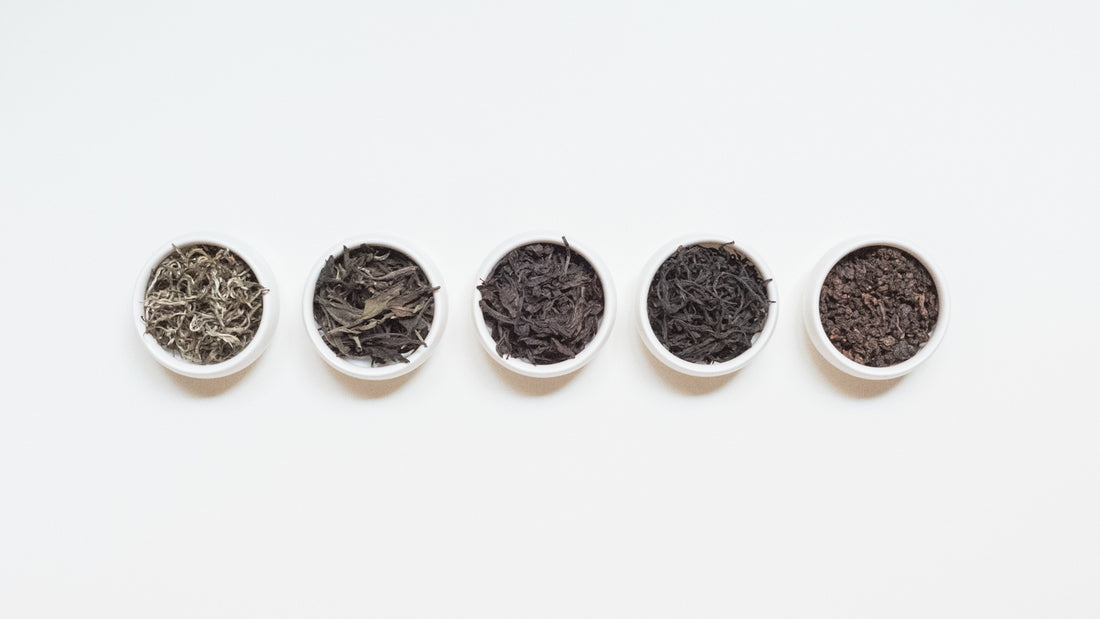In the Vol. 7 Exploration Kit we are going to explore teas from China, Taiwan, and India. You'll find two white teas, two black teas, and an oolong tea. We’ll taste a black tea from Yunnan, one that is of a different cultivar than the previous Dian Hong. From Taiwan, we have a black tea that uses a cultivar that’s typically made into oolongs. Our two white teas are both a little out of the box and sit on the opposite end of the flavour spectrum. Finally, we have a famous cliff tea that you might have heard of even if you haven’t tasted it before. Are your senses ready? Check out our tea stories below to learn more about what's in your cup.
BLC White
Wild Indian White
Big Red Robe
Four Seasons Black
Wild Purple Black
Here's a map to give you an idea of the journey this Exploration Kit will take you. Locations are approximate and intended to serve as a visual guide only.
BLC White

碧螺春白茶
White Tea
Spring 2022
Simao, Yunnan, China
While we enjoy many classic teas, we love coming across tea with innovation. This BLC White is a great example of how progressive the tea industry in China is in pushing the limit. It’s a brainchild with features from different tea regions making it a rather unique white tea.
Notes: Floral, Vegetal
Gongfu:
4g | 100ml | 80c | 5-10 secs
Western:
2g | 250ml | 80c | 1 min
A first flush spring harvest, this BLC White is processed from tea leaves that’s a cross between native Yunnan big leaf varietal and Jiangsu Bi Luo Chun. The result is a smaller leaf varietal that could withstand the high elevation in Yunnan. The picking standard is with buds only, similar to Silver Needle, which gives the brew a delicate sweetness.
A tea we can't put our fingers on
When we first encountered this white tea, we were surprised by its unique smell and taste. As we looked closely we could understand why. On the nose, we could pick up the floral note typical of Biluochun, yet there is also a slight hint of earthy tone which signified its Yunnan origin. As the tea is brewed, we were greeted by a citrus note found in white tea, followed by sweetness with a slight hint of astringency that one might expect from a green tea or sheng Pu'er.
While it's hard to put our fingers on this tea we had a lot of fun drinking it. We'd love to hear what you think.
Wild Indian White

White Tea
2022
Pherzawl, Manipur, India
White teas have captured the hearts of many in the past decade with their subtle but sweet flavour and this Wild Indian White is no exception. In fact, the sundried tea leaves add a surprise layer of earthiness.
Notes: Stone Fruit, Floral
Gongfu:
3g | 100ml | 80c | 15 secs
Western:
2g | 250ml | 75c | 1 min
This white tea was harvested this year in Pherzawl located in the southern part of Manipur, India. Consisting of one bud and two leaves from untamed tea trees grown in the forest, the leaves were handpicked, withered by hand, and allowed to dry in the sun.
More Than Just Black Tea
As one of the top 5 tea exporters in the world, 80% of the teas produced and exported from India are black teas. But beyond the well-known Indian black teas such as Darjeeling, Assam and Nilgiri, there are other teas produced from lesser-known regions that deserve the spotlight.
Located in Northeast India and bordering Assam, Manipur is home to wild tea tree forests that have been around for decades. While local villages have been using these Camellia Sinensis var. Assamica as tribal healing ingredients, tea producers are using them to create orthodox teas to share the richness of the Manipur forests in recent years.
We hope this wild white tea will put Manipur on your radar and serve as an entry point to explore other tea types from India.
Big Red Robe

大紅袍
Oolong Tea
Spring 2021
Wuyishan, Fujian, China
After Qilan in Vol 3 and Rou Gui in Vol 5, we are so excited to finally bring you the star of Wuyi cliff tea - Big Red Robe. Arguably the most famous Wuyi cliff tea, it’s usually the first cliff tea one would be introduced to or even heard of. It is also a tea that would make an impression with its intoxicating flavor profile and mouthfeel.
Notes: Chocolate, Spice
Gongfu:
4g | 100ml | 98c | 10-15 secs
Western:
3g | 250ml | 98c | 2-3 mins
This Big Red Robe is harvested this year and processed as a medium roasted oolong. After months of resting the roastiness has mellowed out, yet still enough to warm you up in the wintry months. While there is the familiar aroma of cliff tea, the hint of chocolate is also detected making it a cozy tea to sip down.
Story of Big Red Robe
Coming from one of the historical tea regions, it is sometimes difficult to trace the tea origin. There are a few versions of how the name Big Red Robe came about, and here’s the one that’s most circulated. In the Ming Dynasty (1200's), a scholar who was on the way to the Capital for the imperial exam felt ill in Wuyishan. A Buddhist monk brewed him tea which miraculously cured his upset stomach. He then passed the exam with flying colour and became a scholar-bureaucrat. Feeling grateful, he returned to Wuyishan to thank the monk and was brought to visit the tea plant. He proceeded to drape his red robe over the tree as an honor, and that's how it got the name.
Nowadays, the six mother bushes of Big Red Robe are under protection and prohibited from harvesting. But no worries, we are still able to enjoy this exceptional tea, thanks to asexual propagation, as well as expert blending.
Four Seasons Black


四季春紅茶
Black Tea
Spring 2021
Mingjian, Nantou, Taiwan
Si Ji Chun (四季春), or forever spring, is a popular tea cultivar in Taiwan. As suggested by its name, this tea cultivar has extreme tenacity and treats all seasons as spring, which provides a steady supply all year round. Most Si Ji Chun is processed into oolong tea for the best result, but with tea processing technology advancement, we are finally being able to enjoy a black tea version of this cultivar.
Notes: Sweet, Oolong
Gongfu:
5g | 100ml | 95c | Rinse - 40 secs
Western:
3g | 250ml | 95c | 2-3 mins
This Four Seasons Black tea is harvested in Spring from a certified organic tea plantation. While it has a lighter mouthfeel, we also love how it has a slight hint of oolong making it a very fun black tea to enjoy.
About Four Seasons Black
Traditionally Black Tea was processed from large-leaf varietal (Var. Assamica) due to its robust character. Small-leaf varietal was not considered as it's not easy to achieve full oxidation for black tea processing. In Taiwan, turning the small-leaf varietal (C. Sinensis) into black tea was first experimented in Ming Jian by the local farmers with a scientific and modern approach. The popularity of small-leaf black teas soon spread to Taitung, as it generates economic value during summer, which was normally the "fallow period" for tea picking and production. Feedback from the market proved this to be a welcoming move as people seek out black tea with different mouthfeel and flavour from typical malty black.
Wild Purple Black

紫芽野紅茶
Black Tea
Spring 2022
Feng Qing, Yunnan, China
With Dian Hong from Vol. 3 winning the hearts of many, we knew there is something special about black tea from Yunnan. And here's another Yunnan black tea for you - a wild purple black tea processed from an indigenous mutated varietal, it gives off an extra kick in taste for Yunnan black tea lovers.
Notes: Fruity, Floral
Gongfu:
5g | 100ml | 95c | 15 secs
Western:
4g | 250ml | 90c | 2 mins
This purple black tea is harvested in mid-March from the high elevated mountainous areas west of Feng Qing. It is a wildly grown varietal that has gone thru natural mutation. Since only a very small percentage of tea plants would go thru this mutation in the wild, purple tea is never widely circulated in the tea market. For this particular purple tea, only 70kg of tea is yielded from this season.
Purple tea tended to give off a bitter taste which might not be everybody’s cup of tea. So we are glad to have found this tea that's full of fruitiness - a great representation of the unique taste from Yunnan, which some said it’s the taste of the Sun.
About Purple Tea
When it comes to purple tea, it is not a reference to the tea liquor but the colour of the fresh tea leaves. Studies showed that this mutation is a defence mechanism - the purple in the leaves is a pigment called anthocyanin, which helps protect the leaves from Sun overexposure. This substance has since proven to be beneficial to health with its high antioxidant content. Even Lu Yu the tea sage has once written “Purple tea is more desirable “ 「茶者,紫為上」in the Classic of Tea.

